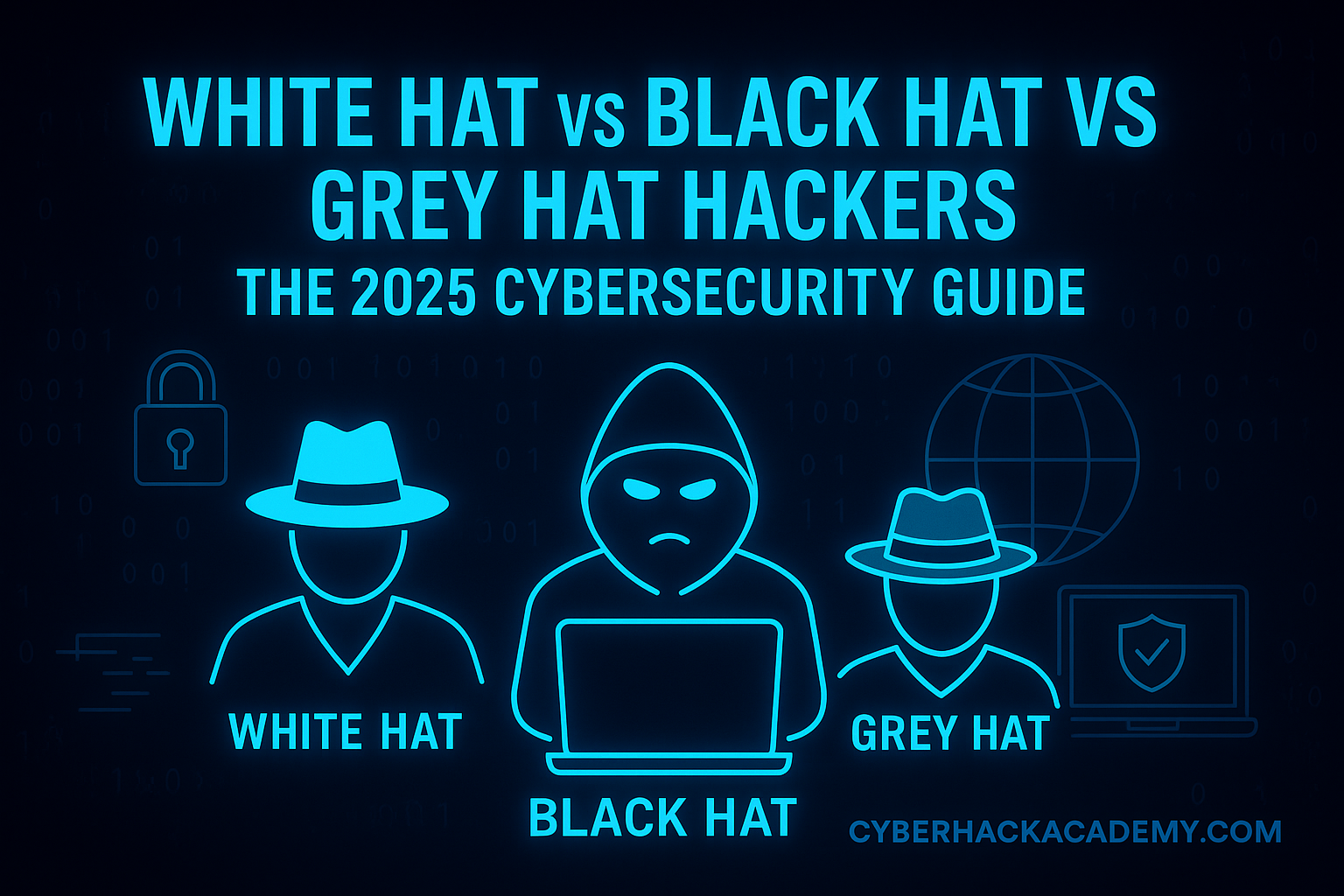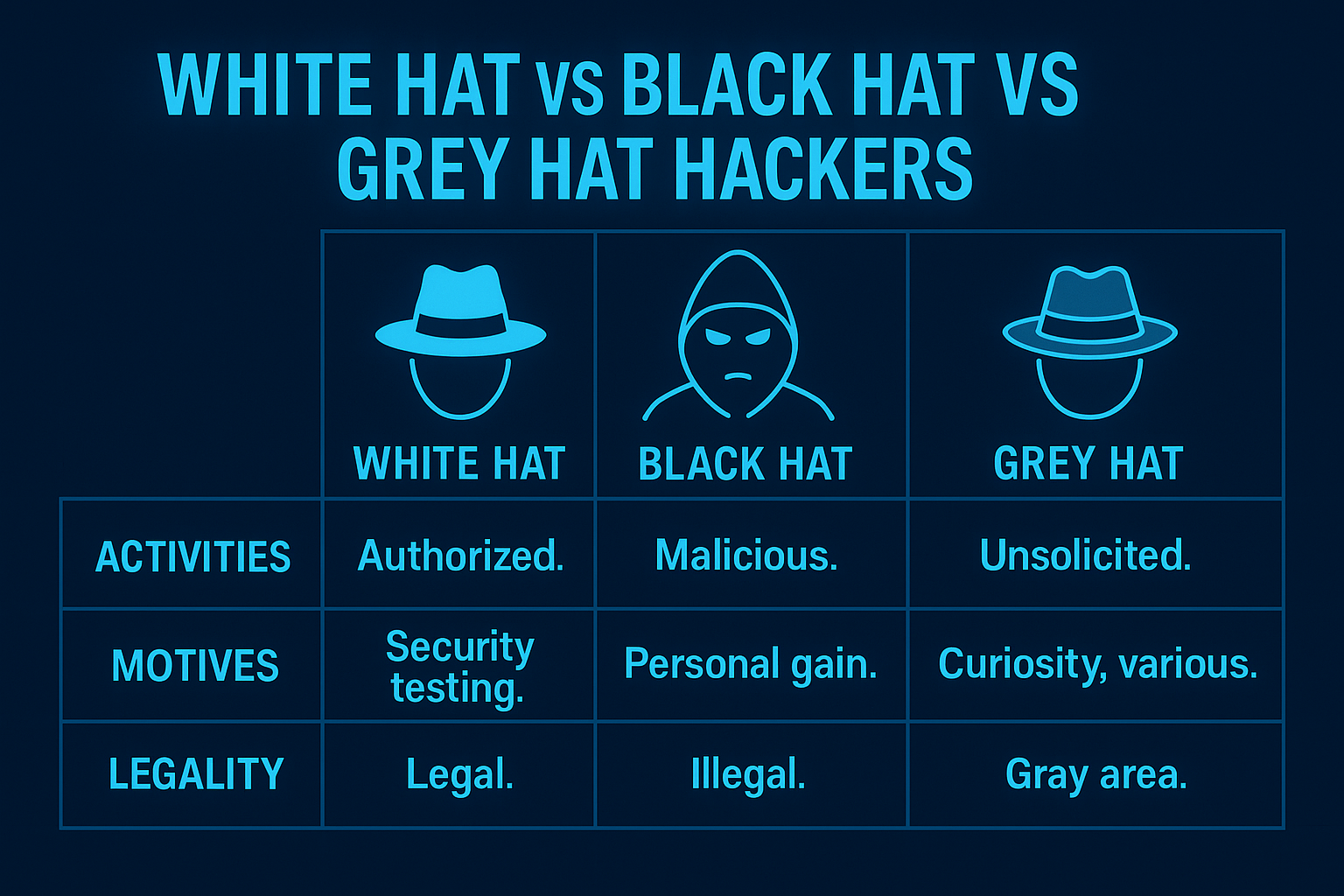Explore the major types of hackers in 2025: white hat, black hat, grey hat, and even blue and green hats. Learn their motivations, legalities, and real-world impact on cybersecurity.

Introduction: Who Are These Hackers?
In the ever-evolving world of cybersecurity, the word “hacker” doesn’t always mean criminal. Some hackers protect, others exploit, and a few operate in the grey. In this 2025 guide, we’ll break down the types of hackers—white hat, black hat, grey hat—and even explore lesser-known types like blue and green hat hackers. Whether you’re a student, cybersecurity enthusiast, or IT professional, this guide will help you clearly understand the hacker landscape.
White Hat Hackers: The Ethical Guardians
Definition: White hat hackers are cybersecurity professionals who use their skills legally and ethically to protect systems and data.
Motivation:
- Strengthening system security
- Getting paid through jobs or bug bounty programs
- Helping companies avoid data breaches
Real-Life Examples:
- Kevin Mitnick (former black hat turned white hat)
- Ethical hackers working with companies like Google and Apple
Tools & Tactics:
- Penetration testing
- Vulnerability assessments
- Compliance audits
Legality: 100% legal — often hired by organizations or governments
Related Read: “Start Here” – Your Cybersecurity Roadmap for Beginners | CyberHack Academy
Black Hat Hackers: The Cybercriminals
Definition: Black hat hackers are individuals who exploit systems illegally for personal, political, or financial gain.
Motivation:
- Stealing data (credit cards, personal info, etc.)
- Selling exploits on the dark web
- Disrupting systems for political or revenge purposes
Real-Life Examples:
- Anonymous (hacktivist group)
- Albert Gonzalez (responsible for one of the biggest credit card thefts in history)
Tactics Include:
- Malware attacks
- Ransomware
- DDoS attacks
Legality: 100% illegal — prosecuted globally
External Resource: Europol on Cybercrime
Grey Hat Hackers: The Ambiguous Middle Ground
Definition: Grey hat hackers operate in the middle—sometimes violating laws or ethics but without malicious intent.
Motivation:
- Fame or recognition
- Forcing companies to fix vulnerabilities
- Curiosity
Real-Life Examples:
- A hacker exposing flaws in public infrastructure without permission
Typical Behavior:
- Breaking into systems without consent but reporting flaws
- May demand a fee after disclosing issues
Legality: Grey zone — can be illegal depending on the action and jurisdiction
The Rise of Ethical Hacking in 2025
With cyber threats increasing daily, ethical hackers are in high demand. Organizations are:
- Hiring full-time security professionals
- Partnering with bug bounty platforms like HackerOne and Bugcrowd
- Offering certifications like CEH (Certified Ethical Hacker)
Why It Matters: Ethical hacking is now a global profession, regulated, and supported by legal frameworks in countries like the US, UK, and India.
Bug Bounty Programs & Legal Frameworks
Bug bounty programs allow ethical hackers to legally test systems and earn rewards.
Popular Platforms:
Legal Considerations:
- Must follow program rules
- Operate within scope
- Avoid using stolen data or blackmail
Bonus: Blue Hat and Green Hat Hackers
Blue Hat Hackers
- Definition: Often hired by companies to test systems before a product launch
- Known For: External security auditing
Green Hat Hackers
- Definition: Newbies passionate about learning hacking
- Known For: Rapidly growing skillset, often in online communities
Comparison Table: White vs Black vs Grey Hat Hackers
| Feature/Type | White Hat | Black Hat | Grey Hat |
|---|---|---|---|
| Legal Status | Legal | Illegal | Often Illegal |
| Motivation | Security, Ethics | Money, Revenge | Curiosity, Recognition |
| Tools Used | Legal Pentesting Tools | Malware, Exploits | Mix of Both |
| Impact | Positive | Harmful | Mixed |
| Real Example | Kevin Mitnick | Anonymous | Hacker disclosing bugs without permission |

Final Thoughts
Understanding the different types of hackers is crucial in the digital age. While black hats pose real threats, white hats play a vital role in defending our systems. Grey hats challenge the ethical boundaries, and newer types like green and blue hats are shaping the future of cybersecurity.
Whether you’re a student stepping into cybersecurity or a seasoned pro, knowing these distinctions helps you stay informed—and secure.
Related Posts:
- Cybersecurity Fundamentals: What Are Threats, Vulnerabilities & Attacks? (2025)
- Top 10 Cybersecurity Certifications for 2025
Tags: white hat hacker, black hat hacker, grey hat hacker, types of hackers, ethical hacking vs cybercrime, cybersecurity 2025, bug bounty, hacker types comparison,

Pingback: Nmap for Beginners: Ultimate Network Scanning Guide